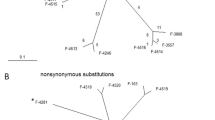Abstract
The Chinese Bai-Ling-Gu is a mushroom named Pleurotus eryngii var. tuoliensis C.J. Mou. This species has been identified as P. nebrodensis or P. eryngii var. nebrodensis. We examined its taxonomic position by analysis of mating, cultivation, and rDNA sequences, and concluded as follows. (1) Bai-Ling-Gu mated with P. eryngii var. eryngii, and the F1 and F2 formed fruit bodies. (2) Bai-Ling-Gu mated with P. eryngii var. ferulae, and the F1 formed fruit bodies. (3) In the di-mon mating test, P. eryngii var. nebrodensis from Sicily mated with monokaryons of P. eryngii var. eryngii but mated hardly at all with those of Bai-Ling-Gu and P. eryngii var. ferulae. The di-mon mating pattern of Bai-Ling-Gu resembled those of P. eryngii var. ferulae. (4) The partial sequences of rDNA ITS1 and IGS1 from the epitype of P. nebrodensis were identical with those from P. eryngii var. nebrodensis from Sicily but differed from those from Bai-Ling-Gu. (5) The strains of P. eryngii var. eryngii and P. eryngii var. ferulae were in a group, the strains of P. eryngii var. nebrodensis from Sicily were in another group, and the strains of Bai-Ling-Gu were in the other group in both the phylogenetic trees based on the ITS1 and the IGS1 sequences. These results led to the conclusion that Bai-Ling-Gu is a variety of P. eryngii and evolved independently in China. It is satisfactory to identify Bai-Ling-Gu with P. eryngii var. tuoliensis C.J. Mou.
Similar content being viewed by others
References
Bao D, Kinugasa S, Kitamoto Y (2004a) The biological species of oyster mushrooms (Pleurotus spp.) from Asia based on mating compatibility tests. J Wood Sci 50:162–168
Bao D, Ishihara H, Mori N, Kitamoto Y (2004b) Phylogenetic analysis of oyster mushrooms (Pleurotus spp.) based on restriction fragment length polymorphisms of the 5′ portion of 26S rDNA. J Wood Sci 50:169–176
Cailluex RA, Diop A, Joly P (1981) Relations d’finterfertilite entre auelaues representants des Pleurotus des Ombelliferes. Bull Soc Mycol Fr 97:97–124
Catherine M, Dubayle B (1983) Taxonomic significance of enzyme polymorphism among isolates of Pleurotus (Basidiomycetes) from umbellifers. Br mycol Soc 81:121–127
Corpet F (1988) Multiple sequence alignment with hierarchical clustering. Nucleic Acids Res 16:10881–10890
Gioia TD, Sisto D, Rana GL, Figliuolo G (2005) Genetic structure of the Pleurotus eryngii species-complex. Mycol Res 109:71–80
Hilber O (1982) Die Gattung Pleutrotus (Fr.) Kummer. Bibliotheca Mycologica band 87. Cramer, Germany
Hsiau PTW (1996) The taxonomy and phylogeny of the mycangial fungi from Dendroctonus brevicomis and D. frontalis (Coleoptera: Scolytidae). Ames, IA, USA: Iowa State University. PhD Thesis
Huang N (1998) Colored illustrations of macrofungi (mushrooms) of China (in Chinese). China Agricultural Press, Beijing, p 96
Inzenga G (1863) Nuova specie di agrico del Prof. Giuseppe Inzenga. Giom Reale 1st. Incoragg Agric Sicil Palermo 1:161–164
Jia SM, Qin M (2006) Domestication and cultivation of Pleurotus nebrodensis in China (in Chinese). Edible Fungi China 25:3–7
Lee SB, Taylor JW (1990) Isolation of DNA from fungal mycelia and single spores. In: Innis MA, Gelfand DH, Sninsky JJ, White TJ (eds) PCR protocols: a guide to methods and applications. Academic Press, San Diego, pp 282–287
Mao X (2000) The macrofungi in China (in Chinese). Henan Science & Technology, Zhengzhou, p 66
Mao X (2005) Promoting a new development for precious mushroom Pleurotus nebrodensis (in Chinese). China (Guang Shui) Symposium on Standardization Production for Edible Mushroom & Products Fair for Rare Mushroom (Pleurotus nebrodensis), Hubei, China, January 17–18, pp 25–27
Mou C, Cao Y, Ma J (1987) A new variety of Pleurotus eryngii and its cultural characters (in Chinese). Acta Mycol Sin 6:153–156
Perrière G, Gouy M (1996) WWW-Query: an on-line retrieval system for biological sequence banks. Biochimie (Paris) 78:364–369
Saccardo PA (1887) Sylloge Fungorum omnium hucusque Cognitorum, vol 5. Patavii, p 347
Tan Q, Romanie CP, Schlagnhaufer C, Chen M, Guo Q, Geml J, Garzon C (2006) DNA fingerprinting of six Pleurotus nebrodensis strains cultivated commercially in China. Acta Edulis Fungi 13:20–23
Venturella G (2000) Typification of Pleurotus nebrodensis. Mycotaxon 75:229–231
Venturella G, Zervakis G, Rocca SL (2000) Pleurotus eryngii var. elaeoselini var. nov. from Sicily. Mycotaxon 76:419–427
White TJ, Bruns T, Lee S, Taylor J (1990) Amplification and direct sequencing of fungal ribosomal RNA genes for phylogenetics. In: Innis MA, Gelfand DH, Sninsky JJ, White TJ (eds) PCR protocols: a guide to methods and applications. Academic Press, San Diego, pp 315–322
Zervakis G, Balis C (1996) A pluralistic approach in the study of Pleurotus species with emphasis on compatibility and physiology of the European morphotaxa. Mycol Res 100:717–731
Zervakis GI, Venturella G, Papadopoulou K (2001) Genetic poly morphism and taxonomic infrastructure of the Pleurotus eryngii species-complex as determined by RAPD analysis, isozyme profiles and ecomorphological characters. Microbiology 147:3183–3194
Zhang JX, Huang CY, Ng TB, Wang HX (2006) Genetic polymorphism of ferula mushroom grown on Ferula sinkiangensis. Appl Microbiol Biotechnol 71:304–309
Author information
Authors and Affiliations
Corresponding author
About this article
Cite this article
Kawai, G., Babasaki, K. & Neda, H. Taxonomic position of a Chinese Pleurotus “Bai-Ling-Gu”: it belongs to Pleurotus eryngii (DC.: Fr.) Quél. and evolved independently in China. Mycoscience 49, 75–87 (2008). https://doi.org/10.1007/s10267-007-0392-2
Received:
Accepted:
Published:
Issue Date:
DOI: https://doi.org/10.1007/s10267-007-0392-2




